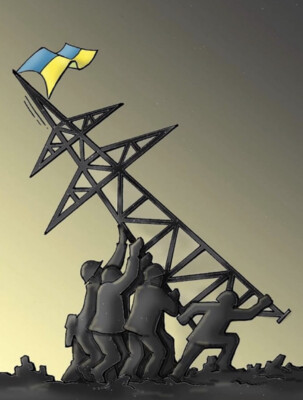Strikes on the energy system of Ukraine: why Putin will fail

There are two ways to go down in history. The Russian Führer, having completely changed the landscape on the western border of God-saved Rus' ™ in ten years, chose the bad one.
He actually revived NATO, the European part of which in 2012 was a pile of headquarters with almost no troops. He even expanded the ego of the Alliance almost to the suburbs of ex-Leningrad (which is really cool). In addition to his renunciation of claims to Europe, he gave everything he could in the Far East, and not even for an alliance, but simply for squeamish neutrality.
But the most grandiose gaff was waiting for him in Ukraine. It is hard to believe now, but ten years ago Putin was one of the most popular politicians in our country, and almost 90% of Ukrainians considered Russians to be friendly people. But it really was so.
Two years later, Russian troops invaded the Ukrainian Crimea and Donbas, and this year the all-out march to the West ("To Kyiv and Lviv!") turned the war into a full-scale one.
However, his plan to take Kyiv in three days did not work. The Great Russian Army turned out to be as much of a myth as the Russian-Ukrainian friendship. His army is best at fighting civilians – and launching missiles and drones on our cities in large numbers. The goal – to freeze more Ukrainians to death – is completely official, as are the calls to expel 10-12 million Ukrainians from the country.
In the energy sector alone, more than a thousand missile launches and drone flights have already been recorded.
They hit Ukraine with all the weapons they have and as hard as they can. They regularly strike at cities like Kharkiv, Zaporizhzhia and Mykolaiv with obsolete Soviet S-300 missiles. In Kherson, fleeing the city, the valiant "liberators" did not forget to blow up the transformers that provide electricity to the city.
In general, up to half of the energy infrastructure and almost all thermal power plants were hit. Some transformer substations have already been shelled a dozen times.
The calculation of the Russian army is very simple: “break not build”, and a cumulative effect of destruction is formed.
Thanks, without exaggeration, to the heroic work of the repairmen, the Russians failed to destroy the integrity of the United Energy System of Ukraine in ten large-scale strikes. Although in November the system was twice on the verge – on November 24, as a result of strikes, all nuclear power plants in the country were stopped.
The most difficult situation is in Kharkiv and Odesa region. Residents of Kharkiv, just three dozen kilometers from the border, have the dubious pleasure of watching missile launches right from nearby Belgorod. The energy system of the city was based on the gas-powered Kharkiv CHPP-5 and the coal-fired Zmiivska TPP fifty kilometers away, plus a flow from the west of the country. They've been targeted for more than a hundred days now. Enemies began to strike at the station transformers at first, and now strikes are also being made on generators. From time to time, the light is cut down throughout the region, and only now the electricity in the region, more often, is “turned on” than “off”. There is still light, and this is extremely upsetting for our Russian "brothers". They even hit the old and low-power thermal power station "Eskhar". In December, the Russian army fired missiles at gas production facilities. The goal was the same – to bring down the production and supply of fuel to cities to the maximum.
In order to make it difficult to transfer current from other regions, they also hit the substations of the neighboring Sumy region (it is also hard there). In Chernihiv, the local thermal power plant was hit with artillery in the spring.
The Russians were not allowed to enter the Odessa region, so they cannot reach it with anti-aircraft missiles (as in Mykolaiv). But it has its own problems - there is practically no local electricity generation. Before the war, the region was connected to nuclear power from the Mykolaiv South Ukrainian Nuclear Power Plant (three units of 1000 MW each) and the Ladyzhynska TPP in the Vinnytsia region.
This amount of energy was enough, in the south of the country there was an energy surplus (plus the world's largest Zaporizhzhia NPP is nearby).
But war came... with missile strikes. The attacks on the Ladyzhynska TPP started back in October. After the first attack, the fire at the transformers was extinguished for seven hours, after the second they managed faster, but by that time the power-generating equipment at the station was already in very poor condition. Since November, strikes have also begun on substations providing supply from the South Ukrainian NPP. At the same time, the new distribution substation of the Dniprovska HPPP was hit (this worsened the overall maneuverability of the system). The substation is new, modern and compact. It turned out that compactness in the presence of such good neighbors is not always a good thing. It seems that in the future it will still have to be moved underground. In the meantime, the amount of electricity produced by local electrical equipment is very small in the region (renewable energy does not work at all in winter). So the situation is...
Because of the raids, not only the light is turned off, but also the heat. At times, almost all of Odessa remained without electricity. Even exotic scenarios were considered for the supply of electricity from Turkish floating power plants (they would have to be located in Romania).
Meanwhile, there are Russian bots and local idiots who want to help spread rumors that it was dark around because of the export of electricity to Hungary. In reality, everything was exactly the opposite, with the help of transit via Hungary, Romania and Transnistria, it was possible to establish at least some kind of energy supply to part of the region. Ironically, the delivery route goes past Russian military bases and the Russian-controlled Moldova District Power Plant. Furthermore, in case of strikes in the south of Ukraine, Chisinau also falls under power outages.
Another good news is the fact that the bases in the Crimea are located nearby, and the flight time of the Iranian "mopeds" to Odessa is minimal. In one of the recent raids, out of 15 “Shaheds”, only five reached the target. Usually, 75% of missiles and drones fired on Ukraine are shot down. This is quite a large number of neutralized drones, but the damage from the rest, those that were not shot down, is enough. In general, when the power engineers say that they need equipment and equipment again, that's exactly what it is.
Besides, it is also necessary to hit back, ideally on the Moscow region. Even perfectly peaceful "Ukrenergo" is telling partners in the West that "as we increase our ability to restore the grid, we must decrease their ability to destroy." Because to survive this winter, we need to work in two directions. Air defense and shelters alone will not solve the issue. In the future, distributed generation is needed. There are projects for the installation of relatively small gas power plants for 20 – 30 MW.
On Monday morning, an Iranian "Shahed" crashed into the 330/110 "Nyvky" substation in Kyiv. The fire lasted for several hours. Many areas of the city fell into darkness again.
This has already become quite a common phenomenon. Also, social networks quite casually discussed why the two-hundred-kilogram "Shahed" still broke through the protection (the transformer had a protective wall and sandbags), and how it is worth strengthening the protection of other stations.
So, let's count how many strikes on our territory the enemy has already made? Since September, the capital has come under almost every major wave of attacks (there have already been nine of them), and missile strikes on neighboring regions are often intended to cut off its energy system.
The Russians are systematically trying to cut off Kyiv from two Western Ukrainian nuclear power plants (Rivne andKhmelnytskyi). Also, missile strikes on the "Kyiv" substation will soon be counted in double digits. There is also a very interesting situation at the Vinnytsia substation, which supplies power to Kyiv. The enemies even remembered the 330 kV line from the Chernobyl NPP, as a result of which there were missile attacks on the Lisova substation.
They also hit the power plant engine room of the Troyeshchyna TPP-6 (they hit the switchgears before). Apart from that, the Darnytsia CHPP built yet in Stalin’s times was hit. In addition to this, drones also hit the Vyshgorod hydroelectric power station (but luckily air defense units shot down almost all the missiles).
Since autumn, the roof of "Ukrenergo" has been left with a trace of the "Shahed" explosion, the Russians even hit the almost hundred-year-old CHPP-3.
In general, the winter is already not boring, and power outages for thirty or more hours for a number of areas are quite a reality. Especially often blackouts occur on the left bank, where CHPP-6, which provides electricity to Troyeshchyna, is damaged.
Military strikes first caused an emotion of shock, but then they began to be perceived as a completely ordinary phenomenon. Now an attempt is being made to freeze the whole country. Such concepts as European values, the understanding that this is the 21st century after all, are beyond the enemy's comprehension. And that's all the facts you need to know about the Russian people now. Writers like Tolstoy and Turgenev are not read there, the Strugatsky Brothers have long been forgotten. Well then, it’s good, the conclusions have been drawn, namely we need to survive.
Kyiv has about 1.1 million users, and in a normal situation the city needs 1,500 MW (about two-thirds for the population and utilities).
However, the reality is very different, and sometimes this figure is twice as low. Also, if we take into account that it includes non-switchable and critical consumers (metro or hospitals) ... It can be understood that in general, generators are not a luxury, but a necessity.
At the beginning of the missile attacks, the city's power engineers divided consumers into three lines, roughly 300 MW each. Within each line there are ten groups. And we tried to stick to schedules. It looked impressive, but as attacks (and damage) became more frequent, schedules of all kinds, from stabilization to planned ones, became more and more blurred. Now the situation in the energy sector is such that it is already clear that until spring it will be very difficult for everyone. The National Bank also plans that the electricity deficit will decrease (but not to zero) only in summer.
We have to consider very different scenarios.
The Russians frankly hope for a complete paralysis of the system... Moreover, the system has already fallen twice (but it was reassembled). It is unlikely that there will be a complete collapse of the system that they expect, but the options will be different and all involve working in 24/7 mode. In fact, many (though not all) have already learned how to work this way. But, unfortunately, there is enough foolishness, and even frank attempts to fight for warm places. The author could have written about the Ministry of Energy, but the editor would have crossed out the obscenity… Many things remained “as always”, in short.
And in the end – more than three hundred days of the "three-day" war. And so far, everything that the "liberators" wanted to achieve is not going according to the plan, so the energy terror will not achieve its goals either. Don't even think about it!
Please select it with the mouse and press Ctrl+Enter or Submit a bug











 Login with Google
Login with Google